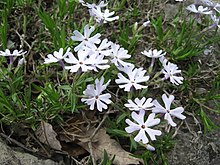| Phlox bifida | |
|---|---|

| |
|
Scientific classification
| |
| Kingdom: | Plantae |
| Clade: | Tracheophytes |
| Clade: | Angiosperms |
| Clade: | Eudicots |
| Clade: | Asterids |
| Order: | Ericales |
| Family: | Polemoniaceae |
| Genus: | Phlox |
| Species: | P. bifida
|
| Binomial name | |
| Phlox bifida Beck
| |
Phlox bifida, commonly known as cleft phlox [1] or sand phlox, [2] is a perennial herbaceous plant in the Polemoniaceae (phlox) family that is native to the central United States.
Description
Phlox bifida is a mat-forming subshrub growing up to 15–30 centimetres (6–12 in) tall in patches of short stems. The stems occasionally branch and are covered with short hairs. Leaves along the stem are opposite, linear, and short, measuring about 5 centimetres (2 in) long. [3] The flowers are pale purple and have 5 lobes, each with a V-shaped notch at the end. [4]
Taxonomy
Two subspecies of Phlox bifida are distinguished based on hair and flower characters. [5] These are:
- Phlox bifida ssp. bifida - Native to sandy regions of the Midwest.
- Phlox bifida ssp. stellaria - Native to limestone glades and cliffs of Kentucky and Tennessee.
Etymology
The genus name Phlox comes from the old Greek word for "flame," referencing flowers that were flame colored. The specific epithet bifada is Latin for "twice-cut", which describes the notched petals. [4]
Distribution and habitat
Phlox bifida is native to the Midwestern United States, the Ozarks, and the cedar glades of Kentucky and Tennessee. [6] The plant can be found in dry woods, on slopes, and on bluff ledges. It typically grows in dry, rocky soils. [7]
Ecology
The flowers bloom in the early spring, and a variety of butterflies and moths feed on the nectar. [3]
References
- ^ "USDA Plants Database". plants.sc.egov.usda.gov.
- ^ Phlox bifida, Missouri Botanical Garden
- ^ a b "Sand Phlox (Phlox bifida bifida)". www.illinoiswildflowers.info.
- ^ a b Denison, Edgar (2017). Missouri Wildflowers (Sixth ed.). Conservation Commission of the State of Missouri. p. 78. ISBN 978-1-887247-59-7.
- ^ "Phlox bifida L.C.Beck | Plants of the World Online | Kew Science". Plants of the World Online.
- ^ "Phlox bifida". County-level distribution map from the North American Plant Atlas (NAPA). Biota of North America Program (BONAP). 2014. Retrieved 21 January 2017.
- ^ "Sand Phlox (Cleft Phlox)". Missouri Department of Conservation.
